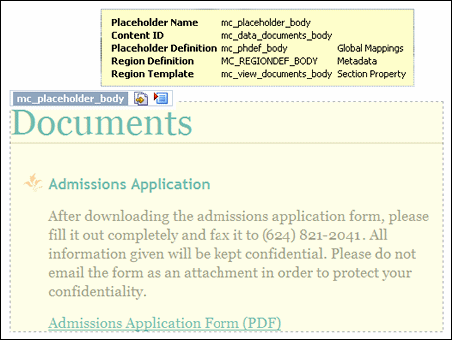| Oracle® Universal Content Management 10g Release 4 (10.1.4) |
 Contents |
 Index |
 Previous |
 Next |
Site Studio Designer Guide > Getting Started With Designer > Contributor Data Files and ...
| Oracle® Universal Content Management 10g Release 4 (10.1.4) |
 Contents |
 Index |
 Previous |
 Next |
Site Studio Designer Guide > Getting Started With Designer > Contributor Data Files and ...
Contributor data files and native documents are used to store content submitted to the site by a contributor. Both files can be assigned directly to a contribution region on a primary page or added as the target of a hyperlink or dynamic list, where they appear on a secondary page.
The two files are different, however, in how you open and edit them:
Contributor data file: A contributor data file is an XML file generated by Site Studio and intended to be opened and edited using the Contributor application. The file is immediately updated and added to the web page.
Native document: A native document is a third-party file that is viewed and edited using the application originally used to create it (for example, Microsoft Word is used for Word documents). When the file is closed, it is converted into a web page (using Dynamic Converter) and then made available to the web page.
To use these files on your site, you must create an editable area (a 'contribution region') on a page template and then assign the data file or native document to the placeholder. If you are using data files, you also must add one or more elements to each region definition. Each element appears as a field in Contributor where a user can add and edit content. You, as the site designer, control the editing options available to the contributor within each element (in its element definition).
After you have set up the contribution region, you assign one of these files to the region using the Assign Content dialog (see Assign Content Dialog). This is available at any time by clicking the Assign Content icon (Figure).
When you first open the Assign Content dialog, you see the site hierarchy on the left and the fully rendered page template with one or more contribution regions on the right. Each contribution region has its own contribution graphic, which shows the name of the contribution region, a status/edit icon, and a menu icon (Figure).
If you hover your mouse cursor over a contribution graphic, its associated contribution region is marked in a yellow box. This is the content that can be edited using the selected contribution graphic. In addition, a tooltip appears that provides useful site design information for the contribution region (such as the associated placeholder name and definition, the content ID of the associated content file, and the associated region definition and template) (Figure).
Contribution Region Marked on Web Page With Tooltip

If not all contribution regions on a page in a site section have content assigned to them, the folder icon of that section in the site hierarchy shows a red 'x' (Figure).
You can specify a new data file or native document or reuse an existing one for each region. You should specify a new file if you want new and unique content to display on that page on the Web site and reuse an existing file if you want the same content to display on multiple pages on the Web site (similar to the decision that goes into reusing other site assets, such as page templates).
|
Note: Contributor data files and native documents are stored in the content server like any other content item. As such, you can choose different metadata or security for each file and consequently, limit what a contributor sees based on his or her login credentials. |
Allowing Contributors to Create Files
In addition to assigning contributor data files or native documents to a region, you can allow contributors to create their own data files and native documents on the Web site.
This adds a whole new dimension to your site, allowing the site to grow without your having to create sections and page templates every time a piece of content is created. To do this, you must allow contributors to add files to the site (an allowed action in an element definition) and then set up areas on the site where those files can appear (a replaceable region on a secondary page).